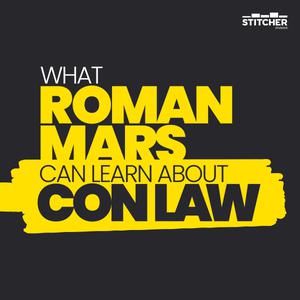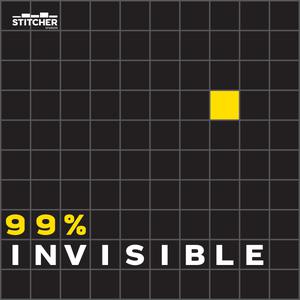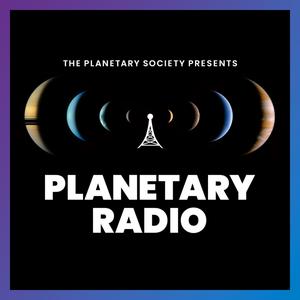
AirSpace
Katie Moyer
Stories that defy gravity from the Smithsonian’s National Air and Space Museum
- 22 minutes 45 secondsAirSpace Revisited: Journey to the Past
As we wait for season TEN (!!!) we're looking back on this season six favorite.
Every day, satellites orbit Earth taking pictures. These images are used for everything from intelligence to weather prediction and even today’s topic – archaeology. When you hear the term “space archaeology” you might envision a khaki-clad astronaut excavating the Moon. But these space archaeologists are actually Earth-bound researchers who use satellite and other aerial imagery to assist in archaeological applications right here on our home planet. This imagery is used to find new archaeological sites, track changes on already discovered ones, and even helps fight looting. On today’s episode, we hear from a researcher using this technology in Central America to see below the trees and assess where ancient structures may have been. And we talk to a Smithsonian scholar who uses satellite data for cultural heritage preservation.
Thanks to our guests in this episode:
- Dr. Kelsey Herndon, University of Alabama in Huntsville. Researcher-NASA SERVIR Program
- Dr. Katharyn Hanson, Cultural Heritage Preservation Scholar- Smithsonian Museum Conservation Institute
Sign up here for the monthly AirSpace newsletter
14 November 2024, 9:00 am - 8 minutes 26 secondsAirSpace Bonus! Voting From a Station Far Far Away
Have you ever wondered how astronauts on the ISS or elsewhere in space vote? It turns out there's a whole Texas law about it. We'll tell you exactly how to cast a ballot from 250 miles up in orbit on AirSpace.
Thanks to our guest in this episode:
- Katherine Schaur - NASA Near Space Network
Sign up here for the monthly AirSpace newsletter
31 October 2024, 8:00 am - 23 minutes 5 secondsDefying Gravity
I don't think we're in Kansas anymore! There are so many things that fly in Oz, from broomsticks to monkeys to bubbles. With the Wicked movie coming out this November, we thought we'd look back on all things flight in the land of Oz and tell you all about how those effects were made for the screen and the stage.
Thanks to our guest in this episode:
- Ryan Lintelman - Entertainment Curator, Smithsonian National Museum of American History
Sign up here for the monthly AirSpace newsletter
24 October 2024, 8:00 am - 39 minutes 59 secondsFlak-Bait, Ooh Ha Ha!
During WWII one plane survived more missions than any other in Europe. Named 'Flak-Bait,' this medium bomber was saved from the scrap heap after the war and immediately donated to the Smithsonian. However, public display and outdated restoration techniques have taken a toll on the plane. We're taking you inside our restoration hanger to learn all about how the Museum's conservators are reversing damage and conserving Flak-Bait so visitors can learn about her contributions for many years to come.
Thanks to our guests in this episode:
- Lauren Horelick - Object Conservator, National Air and Space Museum. Head conservator working on Flak-Bait
- Dr. Jeremy Kinney - Associate Director of Research, Collections, and Curatorial Affairs, National Air and Space Museum. Curator in charge of Flak-Bait
Sign up here for the monthly AirSpace newsletter
10 October 2024, 8:00 am - 22 minutes 37 secondsMovie Mini: Contact
What if there are intelligent lifeforms elsewhere in the universe? And what if all we need to do to find them is to listen to the right radio frequency at the right time? That's what the scientists of SETI (Search for Extraterrestrial Intelligence) have been working on for decades. And that research got the Hollywood Glow-Up back in 1997 with Contact, starring Jodie Foster as SETI researcher Dr. Ellie Arroway. Because if we were alone in the Universe, wouldn't that be such a waste of space?
Sign up here for the monthly AirSpace newsletter
26 September 2024, 8:00 am - 22 minutes 5 secondsBirds of a Feather
It's a bird? It's a plane? Its a guy pretending to be a bird?? We have a very odd aircraft in the collection. It's an ultralight. Small, highly maneuverable and based off the wings hang gliders use to jump off mountains, this particular ultralight was used to help birds migrate. And it starred in the movie in the '90s! When we heard that we were like, say more please.
Thanks to our guest in this episode:
- Russ Lee - curator and chair of the Aeronautic Department, National Air and Space Museum
Sign up here for the monthly AirSpace newsletter
12 September 2024, 8:00 am - 19 minutes 43 secondsLimited Edition
Back in the 'Golden Age' of air travel in the 50s, 60s and 70s going on a trip in an airplane was an event. On those flights you would often get a little souvenir of your air travel; a deck of cards, a little toy, a trading card, captain's wings and a hat for your little tyke. It was a way for you to show off to your friends and for the airline to keep themselves top of mind for your next airline purchase. Like a lot of things from the era, deregulation came along in 1978 and completely changed the flight experience. Now that an airline can offer you a cheap ticket, they're not trying to get your business through tchotchkes. But! There are still some airlines giving out swag. Some of it you have to pony up for first class and some of it you have to ask for. We asked for it (because the AirSpace budget sadly doesn't include first class tickets).
Thanks to our guest in this episode:
- Bob Van der Linden — Curator of Air Transportation, National Air and Space Museum
Sign up here for the monthly AirSpace newsletter
22 August 2024, 8:00 am - 39 minutes 40 secondsLasso the Moon
Over six missions, the Apollo astronauts collected and brought back 842 pounds of Lunar samples. Most of those Moon rocks were put aside for science, but some were earmarked for things like touch rocks (like we have at NASM) or educational disks (which you might have seen if you had a particularly cool science teacher growing up) and to countries and states as diplomatic gifts. But who decides what rocks go where? And how in the heck did the National Cathedral get a rock to put in a stained glass window??
Thanks to our guests in this episode:
- Dr. Ryan Zeigler-Lunar Sample Curator, NASA Johnson Space Center
- Dr. Cari Corrigan- Curator of Antarctic Meteorites, Smithsonian National Museum of Natural History
- Elody Crimi - Photo Curator, Washington National Cathedral Archives
Sign up here for the monthly AirSpace newsletter
8 August 2024, 8:00 am - 23 minutes 25 secondsAirSpace Bonus! My Mom the Rocket Scientist
Our conversation with Jack Black and his brother Neil Siegal about their Mother, Judith Love Cohen was too good just to give you just the taste from the end of our Star Search episode. Here's the extended producers cut with everything from Jack's birth story, to being an engineer in the 70s, to Judy's 2nd career as a book publisher.
Thanks to Jack Black and Neil Siegal for sharing their memories about their Mom.
Sign up here for the monthly AirSpace newsletter
25 July 2024, 9:00 am - 29 minutes 34 secondsStar Search
There are a lot of air and space celebrities; pilots, astronauts, engineers, etc etc. But there's another category of celebrities that are famous for other things but also have surprising ties to air or space. Today we're talking about three of those; a famous tv chef who also helped create a shark repellant for aviators and spacecraft, an actor from Hollywood's golden years who invented the basis for wifi, and an aerospace engineer who worked on Apollo and more--and also has a pretty famous kid. Stay tuned to the end for a special celebrity guest.
Thanks to our guests in this episode:
- Paula Johnson, Curator of Food History-Smithsonian's National Museum of American History
- Dr. Andrew Meade McGee, Curator of Computing-National Air and Space Museum
- Dr. Teasel Muir Harmony, Curator of the Apollo Program-National Air and Space Museum
- Dr. Neil Siegal and his brother, Jack Black
Sign up here for the monthly AirSpace newsletter
25 July 2024, 8:00 am - 29 minutes 54 secondsX-Ray Vision
When the Chandra X-Ray Observatory launched 25 years ago, it showed us our universe in a whole new light (literally). From the remnants of exploded stars to Jupiter's auroras, Chandra has shown us so many beautiful and scientifically important sights. Even after a quarter decade this unique telescope is still giving us new data about black holes and whirling neutron stars and all the things out in space that give off x-rays.
Thanks to our guest in this episode:
- Dr. Daniel Castro - Harvard Smithsonian Center for Astrophysics
- Megan Lin - Chandra X-Ray Observatory Flight Operations Team Lead
Sign up here for the monthly AirSpace newsletter
11 July 2024, 8:00 am - More Episodes? Get the App
Your feedback is valuable to us. Should you encounter any bugs, glitches, lack of functionality or other problems, please email us on [email protected] or join Moon.FM Telegram Group where you can talk directly to the dev team who are happy to answer any queries.
 Sidedoor
Sidedoor
 Twenty Thousand Hertz
Twenty Thousand Hertz
 What Roman Mars Can Learn About Con Law
What Roman Mars Can Learn About Con Law
 Detours
Detours
 99% Invisible
99% Invisible
 Planetary Radio: Space Exploration, Astronomy and Science
Planetary Radio: Space Exploration, Astronomy and Science